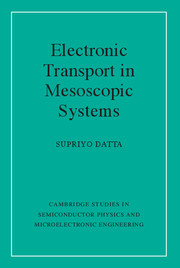Book contents
- Frontmatter
- Contents
- Acknowledgements
- A few common symbols
- Introductory remarks
- 1 Preliminary concepts
- 2 Conductance from transmission
- 3 Transmission function, S-matrix and Green's functions
- 4 Quantum Hall effect
- 5 Localization and fluctuations
- 6 Double-barrier tunneling
- 7 Optical analogies
- 8 Non-equilibrium Green's function formalism
- Concluding remarks
- Solutions to exercises
- Index
3 - Transmission function, S-matrix and Green's functions
Published online by Cambridge University Press: 05 June 2013
- Frontmatter
- Contents
- Acknowledgements
- A few common symbols
- Introductory remarks
- 1 Preliminary concepts
- 2 Conductance from transmission
- 3 Transmission function, S-matrix and Green's functions
- 4 Quantum Hall effect
- 5 Localization and fluctuations
- 6 Double-barrier tunneling
- 7 Optical analogies
- 8 Non-equilibrium Green's function formalism
- Concluding remarks
- Solutions to exercises
- Index
Summary
In Chapter 2 we have tried to establish that there exists a useful quantity called the transmission function in terms of which one can describe the current flow through a conductor. In this chapter we address the question of how the transmission function can be calculated for actual mesoscopic conductors. As we might expect, this chapter is somewhat mathematical and familiarity with matrix algebra is required. It could be skipped on first reading since it is not essential to know how to calculate the transmission function in order to appreciate mesoscopic phenomena, just as it is not necessary to understand the microscopic theory of diffusion or mobility in order to appreciate bulk transport phenomena. However, we will occasionally (especially in Chapter 5) use some of the concepts introduced here.
If the size of the conductor is much smaller than the phase-relaxation length then transport is said to be coherent and one can calculate the transmission function starting from the Schrödinger equation. A large majority of the theoretical work in this field is centered around this coherent transport regime where we can relate the transmission function to the S-matrix as discussed in Section 3.1.
When dealing with a large conductor it is often convenient to divide it conceptually into several sections whose S-matrices are determined individually. We discuss in Section 3.2 how the S-matrices of successive sections can be combined assuming complete coherence, complete incoherence or partial coherence among the sections.
- Type
- Chapter
- Information
- Electronic Transport in Mesoscopic Systems , pp. 117 - 174Publisher: Cambridge University PressPrint publication year: 1995
- 4
- Cited by



